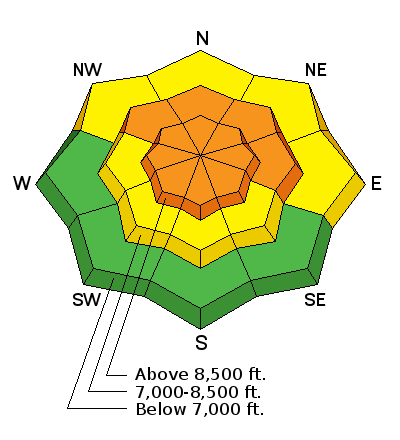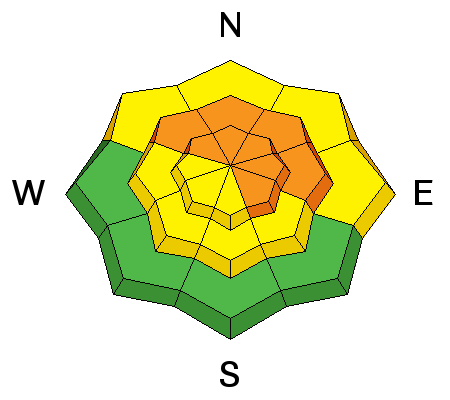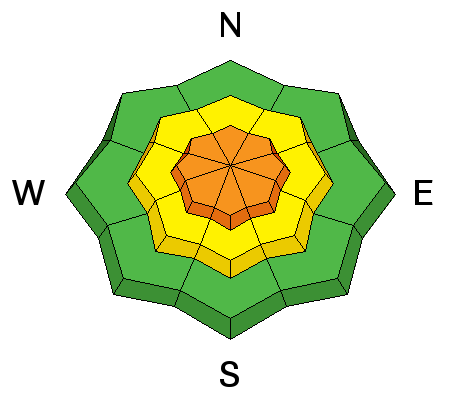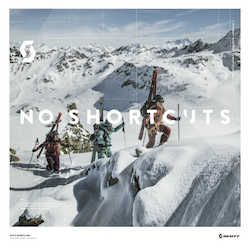Forecast for the Ogden Area Mountains

Friday morning, January 12, 2018
Strong wind with plenty of snow available to transport is keeping the Avalanche Danger at CONSIDERABLE on steep, mid and upper elevation slopes. Large, wide, long running avalanches can be triggered on slope or remotely from below or from adjacent slopes. Avoid steep slopes with freshly wind drifted snow as even a small wind slab could break down in to deeper weak layers and create a larger avalanche.
Those with skills to identify and avoid avalanche terrain will find great riding and turning on low angle slopes less steep than about 30 degrees, which are not below steeper terrain.

 Special Announcements
Special Announcements
Episode 2 of the UAC podcast has been released. Check it out on ITunes, Stitcher, the UAC blog, or wherever you get your podcasts.
 Weather and Snow
Weather and Snow
Overnight a quick hitting small storm rolled through the mountains, leaving behind 1 to 3 inches of snow in places. Unfortunately, this storm also came with a bump in the northwest winds and current speeds at upper elevations are in the 25-35 mph range gusting into the 50's. Temperatures continue to remain on the warm side with ridge line thermometers reporting 25°-30° F. Lower trailheads temps are in the low to mid 30's °F.
The riding and turning conditions out of the wind zone will remain excellent. The sun did poke through the clouds yesterday and there could be a slight zipper crust on the more southerly facing aspects. The snow below 8000' is shallow, rain soaked, heavy, and crusted in many areas.
 Recent Avalanches
Recent Avalanches
Activity quieted down a bit yesterday but resorts were still producing sizable avalanches with explosives. No natural activity was observed. Four days ago, there were large remote avalanches triggered in the Ogden area mountains. Poor snowpack structure is still the main concern with persistent weaknesses still present across the zone. See recent Ogden observations here.
Here's a great video illustrating the shallow poor snowpack structure:
https://youtu.be/vkGJMHIulRk
Our Neighbors to the south - Drew Hardesty, Zinnia Wilson, Paul Diegel, and Bo Torry have an excellent video showing their field day from yesterday below.
Persistent Weak Layer

Description
IT'S JUST PLAIN DANGEROUS OUT THERE - slopes that have not avalanched are hanging in balance, just waiting for a trigger. Today, the wind might be that trigger. Many of yesterday’s avalanches broke well off ridgelines, meaning you can get out on to a slope, and have the slide break above you. Any slide you trigger on a steep slope today will be large enough to bury and kill you. This is due to weak sugary snow that is buried in the snowpack with stronger more cohesive snow on top.
If you're in a hurry you can stop reading here and move onto the wind slab definition. If your drink is still warm continue on for a brief discussion lower down.
In the book " The Art of Science of Prediction" by Philip E. Tetlock & Dan Gardner, they explain the difference between blinking and thinking. The concept is easy, we have two parts to our brains and it's a dichotomy between intuition and analysis - blink vs think. The choice isn't either/or, it is how to blend them in evolving situations. Blinking is the act of using human emotion to make decisions - you quickly decide a slope is safe based on our desire to ride epic powder, you justify things in your mind as stable because your desire is stronger. Analysis, is using all the tools in the tool box and to think, instead of blink: A good start would be to look at the bulls eye clues that tell you if a slope is unstable.
1. Recent Avalanches.
2. Cracking and Collapsing.
3. Significant snow fall within the last 48 hrs.
4. Wind.
5. Recent rapid thaw.
I think you can do the quick math on the list above. The book then tells a quick story about a fire chief called to a routine kitchen fire. "The commander order his men to hose down the fire while standing in the living room. The fire subsided at first but roared back. The commander was baffled. He also noticed the living room was surprisingly hot given the size of the kitchen fire. And why was it so quiet? A fire capable of generating that much heat should make more noise. A vague feeling of unease came over the commander and he ordered everyone out of the house. Just as the firefighters reached the street, the floor in the living room collapsed - because the real source of the fire was in the basement, not the kitchen." There is nothing mystical about an accurate intuition like the fire commander's. It's pattern recognition - like cueing in on the 5 clues to avalanches. If you're seeing avalanches, hearing about avalanches - guess what? YOU CAN TRIGGER AVALANCHES.
Ian McCammon did roughly the same thing when he created the system called ALPTRUTH. He wondered why skilled people were dying in the backcountry. He looked at hundreds of avalanche accidents and came up with a list of seven factors that were present in many, if not all of the backcountry accidents he studied.
The list is below:
1. Avalanches in the past 48 hrs?
2. Loading by snow, wind or rain in the past 48 hrs?
3. Path - are you in an avalanche path?
4. Terrain Trap - Gullies, trees, cliffs or other features that increase the severity of being caught?
5. Rating - Considerable or higher avalanche hazard on the current advisory?
6. Unstable Snow - Collapsing, cracking, hollow sounding snow or other clear evidence of instability?
7. Thaw - Recent warming of the snow surface due to sun, rain or warm air?
The process is simple: for every factor present you give it a score of 1. Ian McCammon found that in almost all of the avalanche accidents he looked at had 3 or more points assigned. To be very clear, if you simply didn't go anytime that 3 or more points are present, you would avoid almost all avalanche accidents. How many points are already checked for today? I count 4.
Wind Drifted Snow

Description
Northwest winds ramped up overnight and into this morning with ridgetop speeds of 25- 35 mph gusting into the 50's. This is creating fresh drifts of wind blown snow. This will provide the extra weight needed to once again tip the balance. Avoid any fresh drift of wind blown snow. If you trigger a wind slab on the northerly facing terrain you will then likely trigger a much deeper and more dangerous avalanche that has potential to step down into deeper weak layers.
Travel adivse - continue to avoid being on, underneath, or adjacent to any terrain steeper than 30°.
Additional Information
We are under a moist northwest flow for much of the day today with a trace to two inches of snow possible. The big headline will be the northerly winds are supposed to remain strong through the morning hours with forecasted speeds in the 20-30 mph range gusting into the 50's at ridgetop. Temperatures will remain balmy and by the afternoon we should warm up into the low 30's at 9000' feet. The storm will exit the area this evening and high pressure returns for the weekend with another storm slated for Tuesday into Wednesday.
General Announcements
CLICK HERE FOR MORE GENERAL INFO AND FAQ
Support the UAC through your daily shopping. When you shop at Smith's, or online at REI, Backcountry.com, Patagonia, NRS, Amazon, eBay a portion of your purchase will be donated to the FUAC. See our Donate Page for more details on how you can support the UAC when you shop.
Benefit the Utah Avalanche Center when you buy or sell on eBay - set the Utah Avalanche Center as a favorite non-profit in your eBay account here and click on eBay gives when you buy or sell. You can choose to have your seller fees donated to the UAC, which doesn't cost you a penny.
This information does not apply to developed ski areas or highways where avalanche control is normally done. This advisory is from the U.S.D.A. Forest Service, which is solely responsible for its content. This advisory describes general avalanche conditions and local variations always occur.




